Homemade jam doesn’t have to be complicated or loaded with artificial ingredients. If you’ve ever tasted that perfect blend of sweet strawberries and tart rhubarb spread over warm toast, you already know why strawberry rhubarb jam is a timeless classic. In this guide, we’re going to walk through everything you need to know to make this delicious preserve from scratch—even without pectin. Whether you’re a first-timer or a seasoned jam maker, this article will cover the ingredients, step-by-step cooking instructions, no-pectin methods, canning tips, flavor variations, troubleshooting, and answers to the most common questions asked by home cooks.
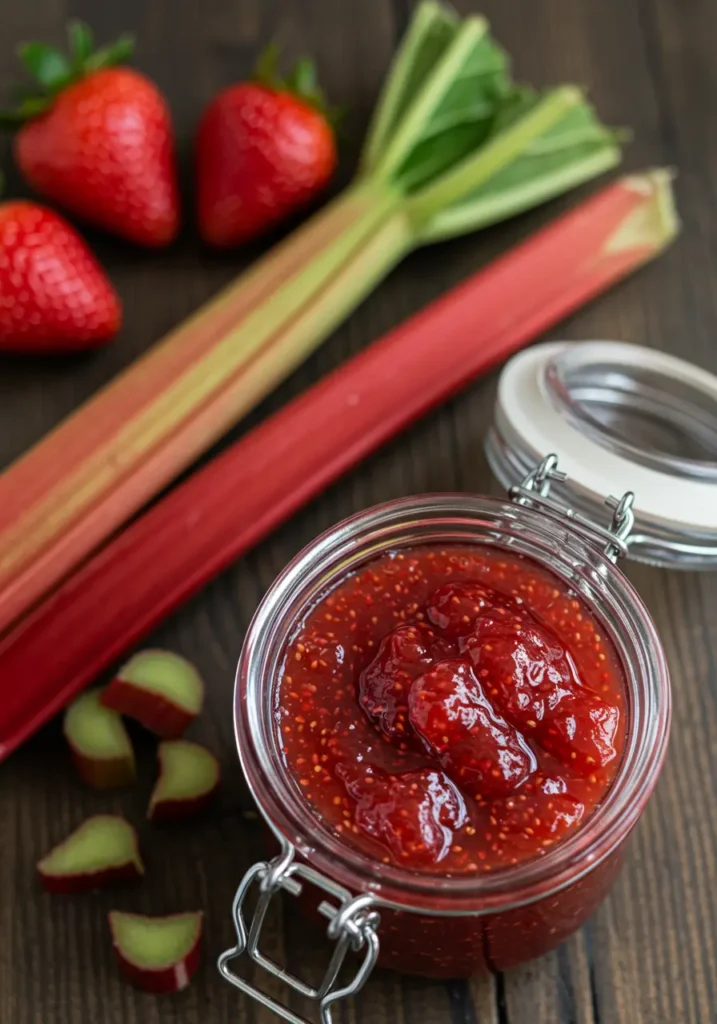
Jump to Section
Table of Contents
Check out Strawberry Rhubarb Pie Recipe: Irresistible Spring Dessert to Savor for a perfect pairing idea to go with your homemade jam.
Let’s dive in with why this jam is so beloved.
Why Everyone Loves Strawberry Rhubarb Jam
The nostalgic charm of strawberry rhubarb jam
Strawberry rhubarb jam has been a staple in American kitchens for generations. The irresistible sweet-tart flavor combo feels like a warm hug from summer. The strawberries offer bright sweetness, while rhubarb contributes a natural tartness that cuts through the sugar, creating a complex, comforting flavor that people crave.
For many, making this jam brings back memories of grandparents stirring pots of bubbling fruit, filling mason jars, and lining pantry shelves. It’s a simple way to connect with heritage, preserve seasonal produce, and enjoy homemade goodness all year long. Unlike store-bought jams that often contain corn syrup or stabilizers, a homemade strawberry rhubarb jam uses real, whole ingredients—and the difference in taste is undeniable.
Don’t miss our Rhubarb Crisp – The Best Classic Dessert for Every Season for another nostalgic treat that highlights the beauty of rhubarb.
Health benefits of rhubarb and strawberries
Both rhubarb and strawberries bring surprising nutritional benefits. Rhubarb is low in calories but rich in fiber, vitamin K, and antioxidants. Strawberries are high in vitamin C, manganese, and plant compounds that support heart health.
Because this recipe doesn’t require pectin and uses lemon juice to help preserve and thicken naturally, it also reduces your need for processed ingredients. You can even reduce the sugar slightly depending on your taste, making it a healthier alternative to commercial spreads. The natural acidity in both rhubarb and lemon juice also helps with safe preservation when canning.
Looking for inspiration? Try our Desserts & Sweet Treats section for more ideas on what to pair your jam with—from scones to cheesecake toppings.
Ingredients Needed for Homemade Strawberry Rhubarb Jam
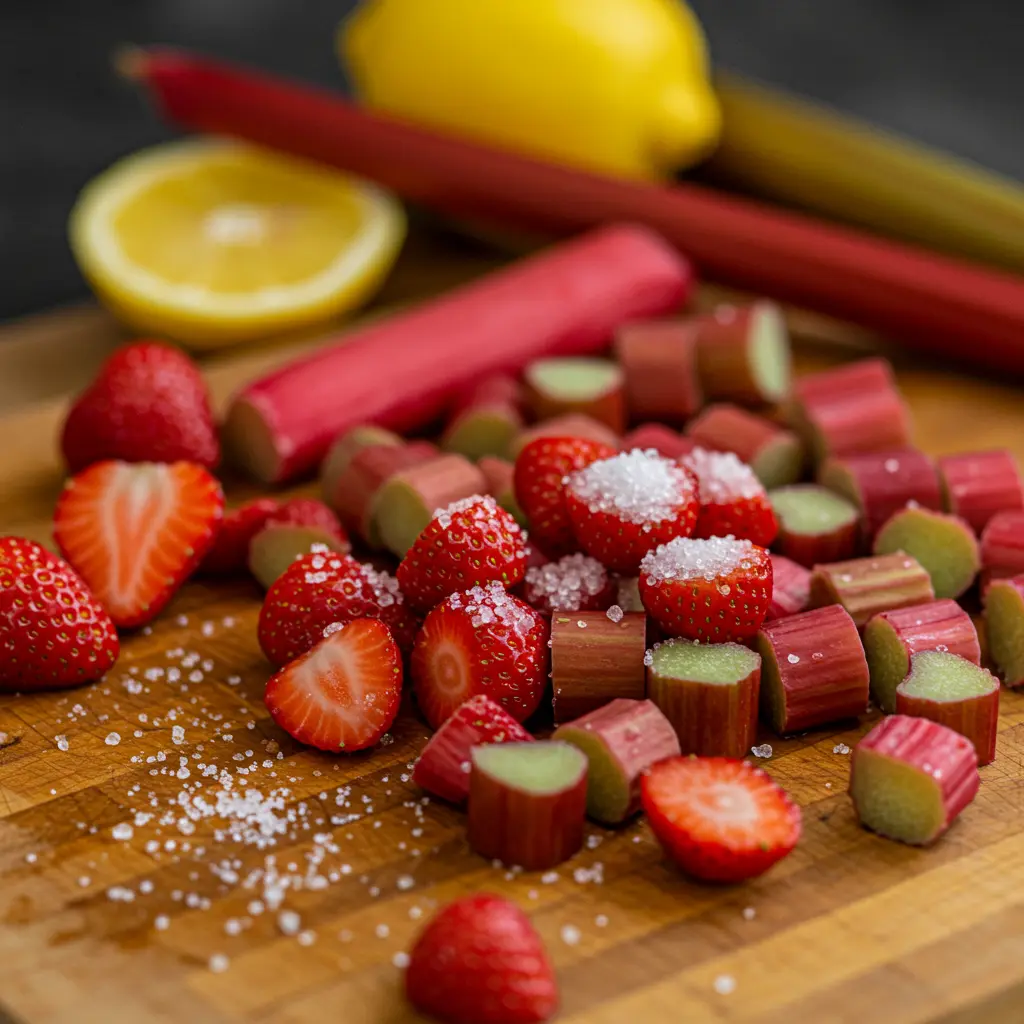
How to choose the best strawberries and rhubarb
When it comes to making a perfect strawberry rhubarb jam, the quality of your produce makes all the difference. You don’t need fancy tools or exotic ingredients—just fresh, vibrant fruit and a bit of kitchen know-how.
Strawberries
Choose ripe, bright red strawberries without any white or green tips. Smaller strawberries tend to have more concentrated flavor, which works beautifully in jam. Avoid overripe or mushy ones, as they can introduce excess moisture, leading to a thinner texture. Wash and hull them before halving or chopping.
Rhubarb
Look for firm, crisp stalks with a deep pink or red color. The redder the stalk, the more naturally sweet the jam will be. Green rhubarb is perfectly usable, but it tends to be more tart, so you may want to balance it with slightly more strawberries or sugar.
And no, you do not need to peel rhubarb—its skin adds both color and flavor to the jam. Just trim the ends and slice it into ½-inch cubes so it cooks down evenly.
Discover great ideas like Dubai Chocolate Covered Strawberries – The Ultimate Sweet Trend You Need to Try if you’ve got leftover strawberries and want to turn them into something extraordinary.
Understanding sugar, lemon juice, and thickening roles
Many people wonder why sugar and lemon juice are so important in jam. Here’s how each ingredient plays its part:
Sugar
Besides sweetening the jam, sugar helps preserve it by drawing moisture out of the fruit and thickening the mixture as it cooks. For strawberry rhubarb jam, the typical ratio is 2 to 2½ cups of sugar per 7 cups of chopped fruit. This balance keeps the jam shelf-stable (when canned properly) and ensures a spreadable texture.
Lemon Juice
Acidity is vital for preserving and gelling your jam. The natural pectin in rhubarb is activated by lemon juice, helping thicken the mixture. It also enhances the flavor, making the strawberries taste brighter and keeping the jam from becoming overly sweet.
Natural Thickeners (No Pectin)
If you’re skipping commercial pectin, cook time becomes your best friend. The jam thickens as the water evaporates and natural sugars caramelize. Just make sure your mixture reaches around 220°F (104°C), which is the magic gelling point. You can also test by placing a spoonful on a cold plate—if it wrinkles when pushed, it’s ready.
Check out Dubai Chocolate Strawberry Cup – The Ultimate Guide to This Viral Middle Eastern Dessert if you’re curious how strawberries are being used creatively in other global desserts.
How to Make Strawberry Rhubarb Jam from Scratch
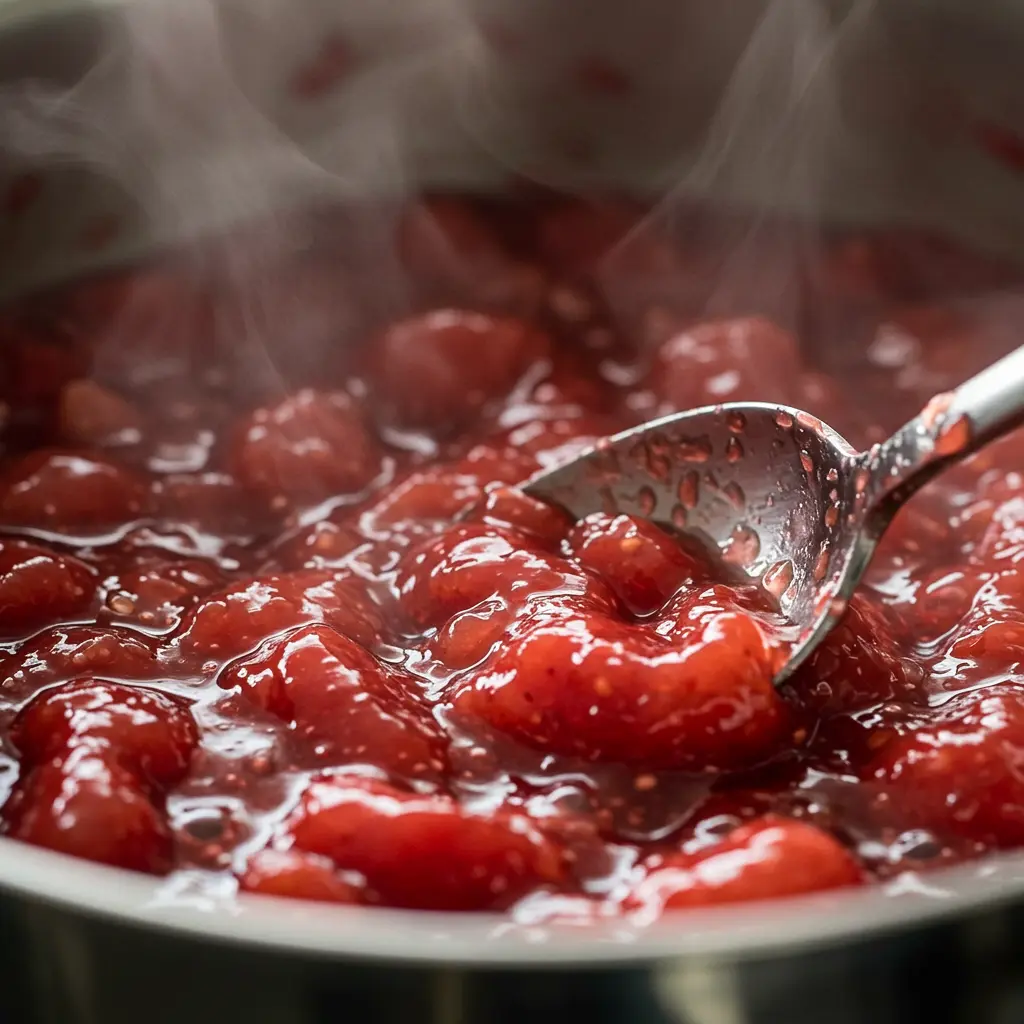
Step-by-step cooking method with temperature tips
Making strawberry rhubarb jam from scratch is straightforward, especially when you use the right technique and give the jam time to develop naturally. Here’s a detailed walkthrough using traditional stovetop cooking without added pectin.
Ingredients You’ll Need
- 5 cups rhubarb (about 3 large stalks), cut into ½-inch cubes
- 2 cups strawberries, hulled and halved
- 2¼ cups sugar
- 1 tablespoon fresh lemon juice
Instructions
- Combine Ingredients:
In a large saucepan, mix the rhubarb, strawberries, sugar, and lemon juice. Let it sit for 10–15 minutes. This maceration step draws out juices, which helps everything cook evenly. - Begin Cooking:
Place the pot over medium heat. As the fruit releases its juices and starts bubbling, stir occasionally to prevent sticking. Once a rolling simmer begins, reduce heat slightly to medium-low. - Simmer Slowly:
Let the jam gently bubble—no violent boiling. Stir every few minutes to prevent burning and monitor the consistency. The fruit will break down and the mixture will reduce slowly. This should take around 45–60 minutes. - Check the Temperature:
Use a candy thermometer to monitor the jam’s temperature. When it reaches 220°F, that’s the ideal gelling point. If you don’t have a thermometer, use the plate test: drop a bit of jam on a cold plate, wait 30 seconds, and push it with your finger. If it wrinkles, it’s done. - Finish and Cool:
Once thickened, remove from heat and let it cool for 5–10 minutes before ladling into clean jars. Be careful—the mixture is very hot and sticky.
This old-fashioned recipe method preserves the bold flavor of your fruit, and since it doesn’t rely on store-bought pectin, it keeps things clean and simple.
Avoiding common mistakes in jam making
Even experienced cooks run into issues with jam. Here are a few to watch out for:
Overcooking
If you let the jam go too long, you risk burning the sugars and dulling the flavor. Always monitor the mixture near the 45-minute mark.
Undercooking
Stopping too soon is a bigger issue—it can lead to a watery spread that doesn’t set. Always check temperature and consistency carefully.
Using too much sugar
It’s tempting to add extra sugar for shelf-life, but that can mask the tanginess of rhubarb and make the jam cloyingly sweet. Stick with the balanced ratio unless you’re adjusting based on fruit ripeness.
Skipping lemon juice
Don’t skip it. Lemon juice is not only a flavor enhancer but also a safety requirement for long-term canning. The acid prevents bacterial growth and supports thickening.
Below is a quick reference table to keep your jam-making on track:
| Problem | Cause | Solution |
|---|---|---|
| Jam too runny | Undercooked, low temp | Cook longer, ensure 220°F |
| Too thick or sticky | Overcooked | Add a little water, reheat gently |
| Flavor too sour | Too much rhubarb | Increase strawberries or sugar |
| Not sealing | Jars weren’t sterilized or sealed properly | Reprocess or refrigerate |
No-Pectin Strawberry Rhubarb Jam Recipe
Why skip pectin and what replaces it
Many home cooks prefer to make strawberry rhubarb jam without pectin—and for good reason. Pectin is a naturally occurring substance found in fruits, but commercial pectin often contains additives. Plus, when using rhubarb and strawberries, you’re working with fruits that already have some natural thickening power, especially when paired with lemon juice and sugar.
Why go pectin-free?
- More control over texture and flavor
- Cleaner ingredient list—just fruit, sugar, and lemon
- No need to rush the cooking process
- No risk of over-gelling or rubbery jam
What thickens jam without pectin? Time and temperature. As the jam simmers, moisture evaporates and the sugar starts to gel. The acid from the lemon juice activates the natural pectin in the rhubarb, helping the mixture set properly without anything extra.
Detailed guide to thickening naturally
Here’s how to confidently thicken your strawberry rhubarb jam the natural way, with no boxed ingredients involved.
1. Focus on the water content
Rhubarb has a lot of water. That’s why we cube it small and give it plenty of cook time. This ensures the liquid reduces enough to achieve that classic jam consistency.
2. Stir and watch the bubbles
When the jam cooks down, you’ll notice the bubbles change. At first, they’re foamy and quick. As the jam thickens, bubbles become glossy, slow, and almost lava-like. This visual cue tells you you’re close.
3. Use a thermometer
Reaching 220°F (104°C) is still your best guarantee for a proper set. Be patient—it can take 45 minutes to an hour depending on your pot size and burner strength.
4. Plate test still works
Spoon a bit of hot jam onto a cold plate. After a minute in the fridge, push your finger through it. If it wrinkles and doesn’t run, it’s ready.
5. Don’t overdo it
There’s a fine line between jam and fruit leather. If it thickens too much on the stove, you can stir in a tablespoon of water while it’s still warm to loosen it slightly.
Here’s a summary table to guide you:
| Method | Indicator | Why It Works |
|---|---|---|
| Visual | Glossy, thick bubbles | Shows sugar reaching gel stage |
| Thermometer | 220°F | Ideal setting temperature |
| Plate Test | Wrinkles when pushed | Classic gelling cue |
| Wooden Spoon | Coats back of spoon | Even texture signal |
By trusting your senses and understanding these natural indicators, you’ll get a perfect pectin-free strawberry rhubarb jam every time. It’s not just easier—it’s tastier.
How to Can and Store Strawberry Rhubarb Jam Safely
Sterilization tips and water bath canning explained
Making strawberry rhubarb jam is only half the process—preserving it correctly is just as important. Whether you plan to keep your jam in the fridge, freeze it, or store it in the pantry, proper sterilization and sealing ensure both safety and shelf life.
Here’s a step-by-step guide for water bath canning, which is ideal for pectin-free jams like this one:
Step 1: Sterilize your jars
Start by sterilizing four 1-cup jelly jars (or equivalent). You can:
- Boil them (along with the lids and rings) in a large pot of water for 10 minutes, or
- Run the jars and rings through a hot dishwasher cycle, then boil the lids separately.
Place the clean jars on a dish towel to avoid thermal shock when filling.
Step 2: Fill the jars
Once your jam is finished and still hot:
- Use a ladle to transfer jam into jars, leaving ¼-inch headspace at the top.
- Wipe the rims clean to ensure a good seal.
- Place the lids on and screw the rings on until hand-tight (not cranked down hard).
Step 3: Process in a water bath
- Lower the jars into a large pot of gently boiling water. Make sure there’s at least 1 inch of water above the tops of the jars.
- Cover the pot and boil for 10 minutes (adjust for altitude if needed).
- Carefully remove the jars and set them on a towel, spaced about an inch apart.
- Let them cool undisturbed for 24 hours.
You should hear a satisfying “pop” from each jar as it seals. If any jar doesn’t seal properly, refrigerate and use within 2 weeks.
Refrigeration vs freezing vs pantry storage
You have several storage options depending on how quickly you plan to use your strawberry rhubarb jam:
| Method | How To | Shelf Life |
|---|---|---|
| Refrigeration | Store in sterilized jar with lid, unsealed | Up to 2 weeks |
| Freezing | Use freezer-safe jar with headroom for expansion | 6 months+ |
| Pantry Storage (Canned) | Use sealed jar after water bath canning | Up to 12 months in cool, dark place |
If you’re going the freezer route, always leave room for expansion in the jar or container, otherwise the jam may crack the glass.
Check out Rhubarb Crisp – The Best Classic Dessert for Every Season for a delicious way to use up a sealed jar of jam in desserts.
Whether you’re gifting your jam, saving it for a cozy winter morning, or keeping a few jars for weekend pancakes, safe storage ensures every spoonful is just as perfect as the first.
Flavor Pairings and Variations
What other fruits pair well with rhubarb
While strawberry rhubarb jam is the most iconic pairing, rhubarb is incredibly versatile and pairs beautifully with many other fruits. If you’re looking to experiment with different flavors while keeping that sweet-tart balance, here are some fruits that naturally complement rhubarb’s tang:
1. Apples
Apples add body and a mild sweetness. They’re also high in natural pectin, which helps thicken the jam without additives. Try mixing in a cup of finely chopped apples with your base recipe.
2. Raspberries
Raspberries deepen the red color and intensify the berry flavor. A half-and-half mix of strawberries and raspberries with rhubarb makes a bold, jammy spread.
3. Cherries
Cherries bring richness and complexity. They cut rhubarb’s sharpness while adding their own subtle tartness.
4. Blueberries
Though not traditional, blueberries mellow rhubarb’s bite and offer a striking purple hue. Great for summer blends.
5. Oranges
Oranges add citrusy depth and pair perfectly with rhubarb’s acidity. You can also zest an orange directly into your strawberry rhubarb jam for a refreshing twist.
Here’s a helpful flavor combination guide:
| Fruit | Flavor Profile | Use With Rhubarb? |
|---|---|---|
| Apples | Sweet, crisp | Yes – boosts texture and pectin |
| Raspberries | Tart, deep berry | Yes – enhances color and flavor |
| Cherries | Juicy, rich | Yes – adds depth |
| Blueberries | Mild, sweet | Yes – unique variation |
| Oranges | Bright, citrusy | Yes – great with zest or juice |
Creative twists on the traditional strawberry rhubarb combo
If you want to upgrade your classic strawberry rhubarb jam while still keeping the focus on those two fruits, here are some flavorful ideas:
Add vanilla or cinnamon
A touch of vanilla extract or a dash of cinnamon can give your jam a warm, dessert-like vibe without overwhelming the fruit.
Try balsamic vinegar
A teaspoon of aged balsamic adds umami and complexity—great for gourmet applications like cheese boards.
Infuse with herbs
Add a sprig of thyme or basil while the jam simmers. Remove before jarring. These herbal notes work surprisingly well with the sweetness.
Go low-sugar
If you’re trying to cut down on sugar, reduce it by up to 25%. Just be sure to cook the jam longer and refrigerate it instead of canning for safety.
Make it spicy
Add a pinch of cayenne or chopped jalapeño for a spicy strawberry rhubarb jam that pairs perfectly with grilled meats or cheese.
Don’t miss our Dubai Chocolate Strawberry Cup – The Ultimate Guide to This Viral Middle Eastern Dessert to see how creative you can get with strawberries in other desserts.
Whether you’re adding vanilla or blending in cherries, the goal is to keep the balance. Rhubarb’s tartness gives your jam structure—your other ingredients should play off that, not compete with it.
Serving Ideas for Strawberry Rhubarb Jam
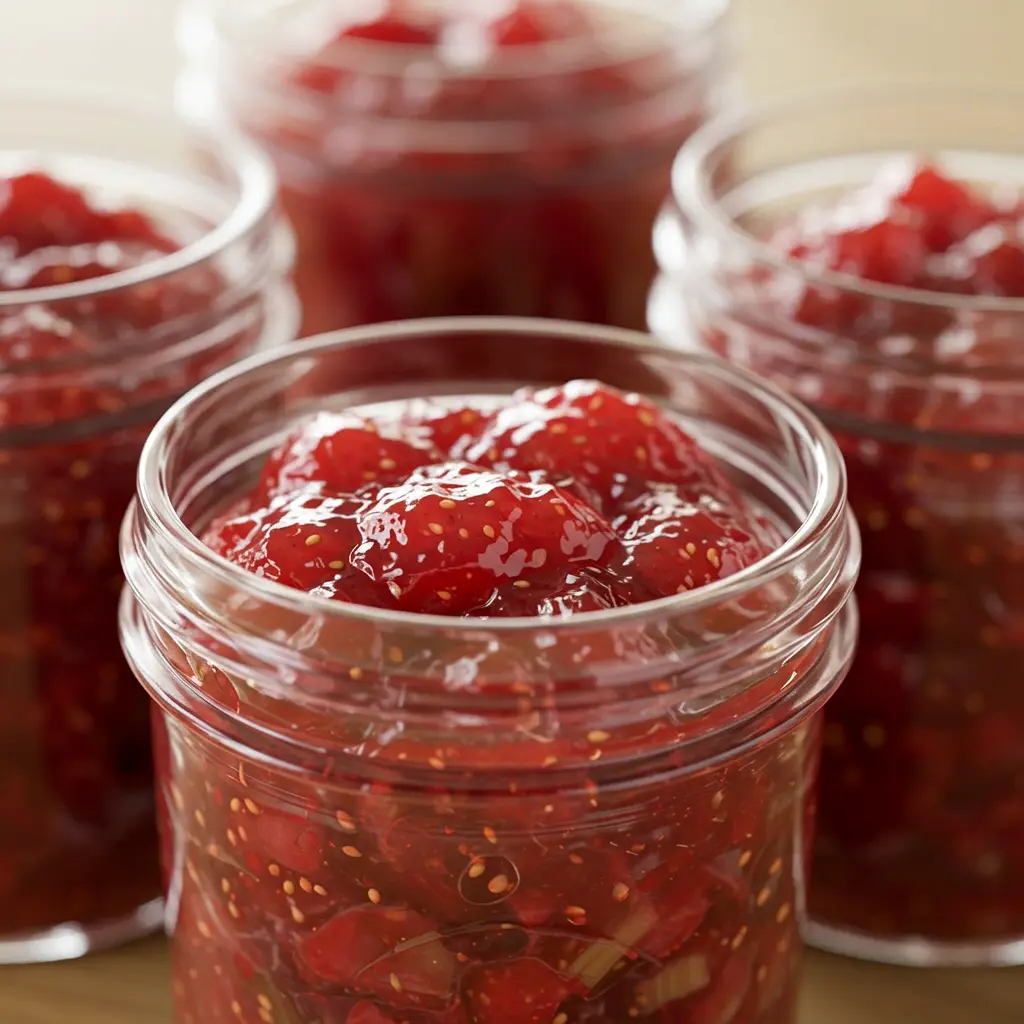
Sweet and savory uses at breakfast, lunch, or dessert
Once you’ve made a batch of strawberry rhubarb jam, the next step is putting it to good use—and trust us, it’s good on just about everything. Whether you enjoy it fresh out of the jar or use it as a secret ingredient in your recipes, this jam adds a bright, fruity note that can transform a dish from plain to unforgettable.
Breakfast Favorites
Start your day with these easy and delicious pairings:
- Spread on toast or English muffins with butter for a classic start.
- Swirl into Greek yogurt or oatmeal to add natural sweetness and a punch of flavor.
- Layer into crepes or pancakes for a vibrant alternative to syrup.
- Top waffles or French toast with a spoonful of jam and whipped cream.
Lunch & Brunch Upgrades
Take your midday meals up a notch:
- Use as a sandwich spread—think turkey and brie with a swipe of strawberry rhubarb jam.
- Create a grilled cheese twist with goat cheese and a layer of jam inside crusty sourdough.
- Add to a charcuterie board alongside soft cheeses, nuts, and cured meats. The tanginess cuts through rich bites beautifully.
Dessert Enhancements
For those who can’t get enough of this jam after dinner:
- Fill thumbprint cookies or linzer cookies with jam for a pretty and tasty treat.
- Drizzle over vanilla ice cream for a fast, fruit-forward dessert.
- Layer into trifles or cake fillings—especially when paired with whipped cream or mascarpone.
Looking for inspiration? Try Desserts & Sweet Treats for even more creative ways to showcase your jam in desserts.
Ideas for gifting and seasonal uses
Homemade strawberry rhubarb jam makes a thoughtful, personal gift that’s perfect year-round. Whether you’re prepping for a holiday, a birthday, or just want to brighten someone’s day, jam in a jar says “I care” in the most delicious way.
Gift-Giving Tips:
- Decorate jars with ribbon and custom labels or tags.
- Include a recipe card for scones, thumbprint cookies, or savory pairings.
- Bundle it with a bread mix or cheese for a themed basket.
Seasonal Occasions:
- Spring: Celebrate strawberry season by gifting jars at brunch or baby showers.
- Summer BBQs: Use jam in marinades or serve alongside grilled pork and chicken.
- Fall: Add to baked goods like muffins or layer into apple crisps.
- Winter Holidays: Create holiday jam gift boxes with spiced variations.
Strawberry rhubarb jam is more than a spread—it’s a versatile pantry essential that works across every season and every course of the meal.
Troubleshooting: Common Jam Issues
Even with the best strawberry rhubarb jam recipe, things don’t always go as planned. Maybe your jam won’t set, turned out too thick, or has an off flavor. Don’t worry—these issues are normal and almost always fixable. Below, we’ll go over the most common problems home cooks face and how to solve them.
Why is my strawberry rhubarb jam runny?
This is the number one issue for beginners, especially when making no-pectin jam.
Possible causes:
- Didn’t reach 220°F (104°C): The natural sugars and acids need that temperature to gel.
- Too much liquid: Either from overly juicy fruit or from skipping the maceration step.
- Not enough cook time: Reducing the water content is key in pectin-free jams.
Fixes:
- Return the jam to the pot and simmer again until it thickens.
- Add a small amount of lemon juice to help activate natural pectin.
- Try the plate test before deciding it’s done—if it doesn’t wrinkle when cooled, it needs more time.
How to fix overcooked or too-thick jam
Overcooking jam can cause it to become sticky, stiff, or overly caramelized.
Signs of overcooking:
- The jam is tough to spread and feels dry.
- The flavor tastes slightly burnt or too sugary.
Fixes:
- Stir in a tablespoon or two of hot water while reheating gently.
- If the texture improves, re-jar and refrigerate for immediate use.
Sometimes over-thickening is caused by too much sugar or evaporating liquid too quickly. Try using a wider pot next time to help control the evaporation rate evenly.
Off flavors or discoloration
If your strawberry rhubarb jam tastes bitter or has turned a darker color than expected, here’s why:
- Too much rhubarb skin: Rhubarb doesn’t need peeling, but very thick stalks can lend a slightly bitter note. Slice thinner next time.
- Metallic taste: Using reactive cookware (like aluminum) can alter the flavor—always use stainless steel or enamel-coated pots.
- Jam turned brown in storage: This is usually due to exposure to light or air leakage in the jar. Store sealed jars in a cool, dark pantry and refrigerate any opened ones.
Jars didn’t seal properly
Proper sealing is essential if you’re water-bath canning.
Causes:
- Jam spilled on the rim before sealing.
- Lids or rings weren’t sterilized correctly.
- Rings screwed on too tight or too loose.
Fixes:
- Reprocess the jars within 24 hours or refrigerate them and use within 2 weeks.
- Always wipe jar rims with a clean cloth before sealing.
Here’s a quick troubleshooting table to reference:
| Problem | Cause | Fix |
|---|---|---|
| Runny jam | Low temp or short cook time | Reheat, reduce, test again |
| Over-thick jam | Overcooked or too much sugar | Stir in hot water and reheat |
| Bitter flavor | Thick rhubarb skin or wrong pot | Use thinly sliced stalks, non-reactive pot |
| Not sealing | Dirty rims, improper tightening | Clean rims, reprocess, or refrigerate |
| Discoloration | Light exposure or air | Store in dark pantry, check for seal |
These solutions can rescue a batch that’s not quite right and help you master the process for next time. Strawberry rhubarb jam may be a classic, but like all great recipes, it benefits from learning as you go.
Strawberry Rhubarb Jam FAQs
You’ve mastered the process, but questions always come up when making homemade jam—especially one as popular as strawberry rhubarb jam. Below are six commonly asked questions (and their answers) to help clarify key points and ensure your jam turns out perfect every time.
How to make strawberry and rhubarb jam?
Making strawberry rhubarb jam is as easy as combining fresh fruit, sugar, and lemon juice in a saucepan. Cook it slowly over medium heat until it thickens and reaches 220°F. No pectin is necessary, and the entire process takes about 45–60 minutes. Simply sterilize jars, fill while hot, and refrigerate, freeze, or can using a water bath.
Do you need to peel rhubarb before making jam?
No, peeling rhubarb is unnecessary. In fact, the colorful skin of the rhubarb adds beautiful reddish hues and extra flavor to the jam. Just be sure to wash thoroughly and cut into small ½-inch pieces for even cooking.
What fruit mixes well with rhubarb?
Aside from strawberries, rhubarb pairs well with:
Apples (for a naturally sweet and thick texture)
Raspberries (to intensify the berry flavor)
Cherries (adds richness and body)
Oranges (for a citrusy brightness)
Blueberries (for a sweeter, unique spin)
How to make strawberry rhubarb jam without pectin?
To make strawberry rhubarb jam without pectin:
Combine equal parts strawberries and rhubarb with sugar and lemon juice.
Cook slowly until the mixture reaches 220°F.
Use the plate test or spoon test to check for proper thickness.
The key is patience—cooking longer allows the fruit’s natural pectin to activate.
What thickens jam without pectin?
Natural pectin in fruits like rhubarb and lemon juice thickens jam when heated to the correct temperature. As the water evaporates, the sugars begin to gel. Stirring often and reducing the mixture gradually ensures your strawberry rhubarb jam thickens beautifully without needing any boxed pectin.
Why add lemon juice when making strawberry jam?
Lemon juice plays two crucial roles:
Flavor enhancer: Brightens the sweetness of the strawberries and balances rhubarb’s tartness.
Preservation and thickening: Its acidity helps stabilize the jam, activate natural pectin, and lower the pH, which is essential for long-term storage safety.
Check out Strawberry Rhubarb Pie Recipe: Irresistible Spring Dessert to Savor to see another way to mix rhubarb with fruit for amazing results.
Conclusion: Homemade Strawberry Rhubarb Jam is Easier Than You Think
Making your own strawberry rhubarb jam isn’t just a delicious kitchen project—it’s a chance to slow down, savor seasonal fruit, and create something meaningful you can share. Whether you’re canning for the pantry, gifting to friends, or just want to enjoy a flavorful spread with breakfast, this jam delivers a perfectly balanced blend of tart and sweet, without the need for pectin or preservatives.
By following the tips, recipes, and troubleshooting techniques in this guide, you’ll feel confident from your first jar to your fiftieth. Homemade jam is more than food—it’s a memory in the making.
Don’t miss our Rhubarb Crisp – The Best Classic Dessert for Every Season for another idea that uses rhubarb’s tartness in delicious ways.
For more daily recipes check out our daily meals on Facebook and Pinterest!
Print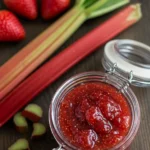
Strawberry Rhubarb Jam – The Best 5-Step Recipe Without Pectin
- Prep Time: 15 minutes
- Cook Time: 1 hour
- Total Time: 1 hour 15 minutes
- Yield: 4 cups 1x
- Category: Preserves & Jams
- Method: Stovetop, Canning
- Cuisine: American
- Diet: Vegetarian
Description
This homemade strawberry rhubarb jam recipe is a sweet-tart preserve that’s simple to make and doesn’t require any pectin. Just four ingredients and an hour on the stovetop yield a naturally thickened jam perfect for spreading, canning, or gifting.
Ingredients
5 cups rhubarb, cut into ½-inch cubes (about 3 large stalks)
2 cups strawberries, hulled and halved (about 1 pint)
2¼ cups granulated sugar
1 tablespoon fresh lemon juice (from about ½ a lemon)
Instructions
Combine the chopped rhubarb, halved strawberries, sugar, and lemon juice in a large saucepan. Let sit for 10–15 minutes to macerate and release juices.
Set the saucepan over medium heat and bring to a gentle simmer, stirring occasionally.
Once bubbling, reduce heat to medium-low. Simmer gently, stirring frequently, for 45–60 minutes, or until the jam thickens and reaches 220°F.
Perform the plate test: place a spoonful on a cold plate, chill for 1 minute, and push with your finger. If it wrinkles, the jam is ready.
Let cool for 5 minutes before ladling into sterilized jars. Seal and refrigerate, freeze, or process in a water bath for long-term storage.
Notes
No pectin is needed thanks to the natural pectin in rhubarb and acidity of lemon juice.
For a deeper flavor, try adding vanilla extract, a pinch of cinnamon, or a few crushed raspberries.
Jam will continue to thicken slightly as it cools.
For water bath canning, boil sealed jars for 10 minutes and cool undisturbed for 24 hours.
Nutrition
- Serving Size: 1 tablespoon (20g)
- Calories: 45
- Sugar: 10g
- Sodium: 0mg
- Fat: 0g
- Saturated Fat: 0g
- Unsaturated Fat: 0g
- Trans Fat: 0g
- Carbohydrates: 11g
- Fiber: 0.3g
- Protein: 0.1g
- Cholesterol: 0mg
Keywords: strawberry rhubarb jam, no pectin jam, homemade fruit preserves, rhubarb jam recipe
